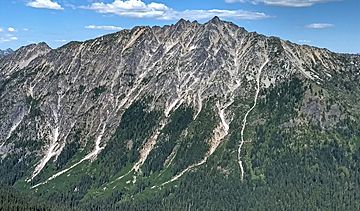The Cradle (Washington) facts for kids
Quick facts for kids The Cradle |
|
|---|---|

The Cradle, southwest aspect
|
|
| Highest point | |
| Elevation | 7,467 ft (2,276 m) |
| Prominence | 2,107 ft (642 m) |
| Isolation | 5.74 mi (9.24 km) |
| Parent peak | Ingalls Peak (7,662 ft) |
| Geography | |
| Location | Alpine Lakes Wilderness Washington state, U.S. |
| Parent range | Cascade Range Wenatchee Mountains |
| Topo map | USGS The Cradle |
| Geology | |
| Age of rock | Cretaceous |
| Type of rock | Granite |
| Climbing | |
| First ascent | 1944 |
| Easiest route | Scrambling class 3 South ridge |
The Cradle is a tall mountain with two peaks in Chelan County, Washington state. It stands about 7,467-foot (2,276-metre) high. The mountain gets its name from the dip between its two peaks, which are almost the same height. The Cradle is located inside the Alpine Lakes Wilderness. It is also part of the Wenatchee Mountains, which are a smaller group within the larger Cascade Range.
The closest higher peak to The Cradle is Jack Ridge, about 5.7 mi (9.2 km) to the east-southeast. Rain and melting snow from the mountain flow into small streams. These streams then join Icicle Creek, which eventually flows into the Wenatchee River. The first time someone climbed the south peak was in 1944. This climb was done by Gene Paxton and Dwight Watson. The north peak was climbed later in 1952 by Bill and Gene Prater.
Mountain Weather: What to Expect
Most of the weather that affects The Cradle starts over the Pacific Ocean. These weather systems move east towards the Cascade Range. As they get closer to the mountains, the air is forced to rise. This rising air cools down and drops its moisture as rain or snow. This process is called Orographic lift.
Because of this, the Cascade Mountains get a lot of rain and snow. Winter months usually bring cloudy weather and heavy snowfall. However, during the summer, high-pressure systems over the Pacific Ocean often lead to clear skies and sunny days.
How The Cradle Was Formed
The Alpine Lakes Wilderness is known for its rugged landscape. It has jagged peaks, sharp ridges, and deep valleys carved by glaciers. You can also see huge granite walls and over 700 mountain lakes. These amazing features were created by geological events that happened millions of years ago. These events led to the varied landscape and big changes in elevation across the Cascade Range.
The Cascade Mountains began to form millions of years ago. This was during the late Eocene Epoch. At that time, the North American Plate was slowly moving over the Pacific Plate. This movement caused many periods of volcanic activity. Also, small pieces of the Earth's crust, called terranes, joined together. This helped create the North Cascades about 50 million years ago.
Later, during the Pleistocene period, which started over two million years ago, glaciers played a big role. Huge sheets of ice moved across the land many times. As they moved, they scraped away rock and left behind debris. The last glaciers in the Alpine Lakes area started to melt and retreat about 14,000 years ago. They had moved north of the Canada–US border by 10,000 years ago. The valleys in this area now have a U-shape. This shape was created by the glaciers. The combination of land being pushed up (uplift) and cracks forming in the Earth's crust (faulting), along with glaciation, created the tall peaks and deep valleys you see today in the Alpine Lakes Wilderness.



